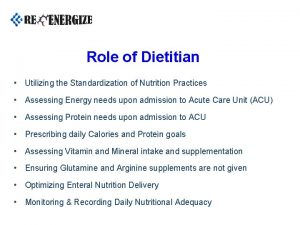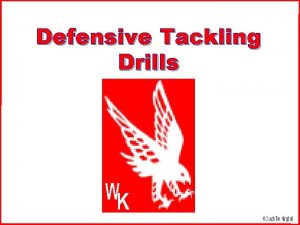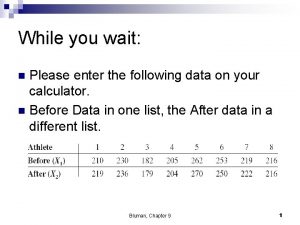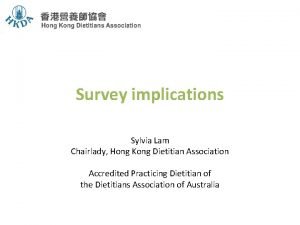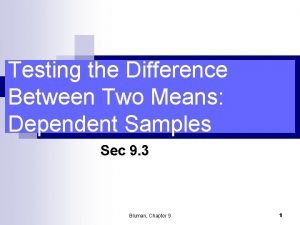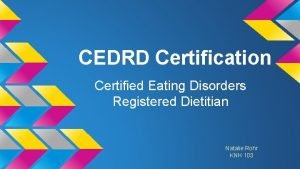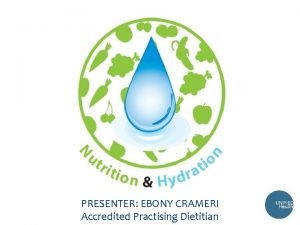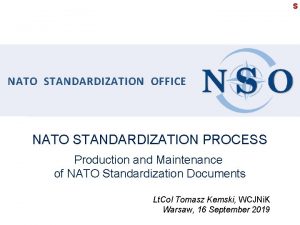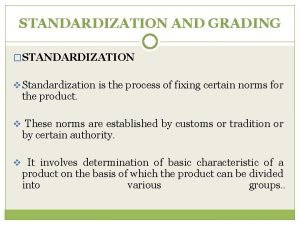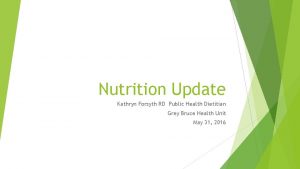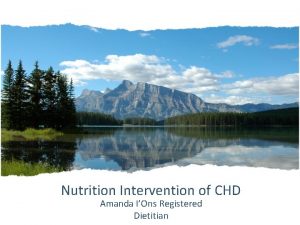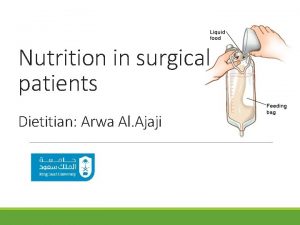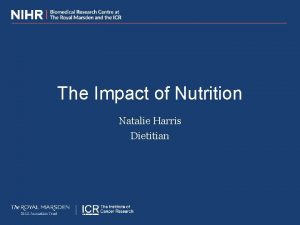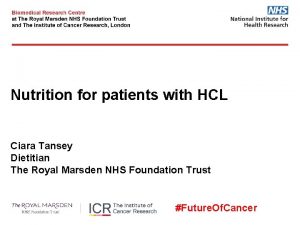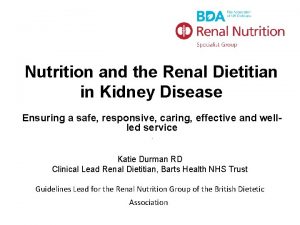Role of Dietitian Utilizing the Standardization of Nutrition















- Slides: 15

Role of Dietitian • Utilizing the Standardization of Nutrition Practices • Assessing Energy needs upon admission to Acute Care Unit (ACU) • Assessing Protein needs upon admission to ACU • Prescribing daily Calories and Protein goals • Assessing Vitamin and Mineral intake and supplementation • Ensuring Glutamine and Arginine supplements are not given • Optimizing Enteral Nutrition Delivery • Monitoring & Recording Daily Nutritional Adequacy

Standardization of Nutrition Practices • To reduce the effect of varying nutritional practices as confounding factors on the outcomes of The RE-ENERGIZE study, it is important to standardize (as much as possible) the following: • Prescription of Enteral and Parenteral Nutrition • Micronutrient delivery • Withholding Feeds for High Gastric Residual Volumes • We recommend compliance with the following nutritional practices. • This will allow for most current practices to continue.

1) Prescribed Energy Needs • Calculated by using : • Indirect Calorimetry, a predictive equation, or a simple weight-based formula • On average, this should not lead to a prescription of less than 30 kcal/kg • Weight • Pre-burn dry weight should be used when calculating energy needs. • For Obese patients, if your standard practice is to adjust for obesity, follow your standard practice. If you do not have an obesity adjustment practice, use the formula below. • Adjusted Body Weight (ABW) = Ideal Body Weight (IBW) based on a BMI of 25 + [(pre-burn dry weight – IBW) x 0. 25]

2) Prescribed Protein Needs • Calculated According to % burn surface area If > 50% burns, use 1. 5 g/kg/day to 2. 5 g/kg/day If < 50% burns, use 1. 2 g/kg/day to 2 gm/kg/day • Pre-burn dry weight should be used when calculating protein needs. • For Obese patients, if your standard practice is to adjust for obesity, follow your standard practice. If you do not have an obesity adjustment practice, use the formula below. • Adjusted Body Weight (ABW) = IBW + [(pre-burn dry weight – IBW) x 0. 25]

3) Vitamin & Mineral Prescription • Should be given as follows or depending upon blood levels (if blood testing is done as part of routine practice): Vitamin C: 0 -1000 mg/day Vitamin A: 0 -10, 000 IU/day Vitamin D: according to serum levels Vitamin E: 0 -420 mg/day Zinc (not elemental): 0 -220 mg/day Copper Sulfate: 0 -4. 5 mg/day Selenium: 0 -500 micrograms/day Magnesium: 0 -600 mg/day Folate: 0 -1500 mg/day Thiamin: 0 -110 mg/day

3) Vitamin & Mineral Prescription • Early supplementation by high dose IV Vitamin C (66 mg/kg/hr) within the first 48 hrs is allowed. Standard multivitamin/mineral preparations are allowed (IV, NG or po). • These ranges of vitamins/minerals/trace elements may be provided as supplementation over and beyond what is present in the standard enteral/parenteral nutrition. OR • These ranges of vitamins/minerals/trace elements may be provided as the total amounts. This means that the amounts received from enteral/parenteral nutrition are to be subtracted from the total ranges and the remainder is given as supplements.

4) Specialized nutritional formulas are not allowed such as: i. Arginine enriched formulas (formulas that contain >6 gms arginine/L) • Pivot ® (13 g/L) • Perative ® (8 g/L) would not be allowed ii. Glutamine supplements or formulas enriched with glutamine • Impact ® Glutamine (15 g/L) • VIVONEX ® Plus (13. 5 g/L) • GLUTASOLVE ® (15 g/L) /other glutamine powders • Juven® (7 g/L) Formulas with glutamic acid inherently present are allowed To minimize any potential contamination, patients that have received glutamine for >24 hrs before randomization, should NOT be included.

5) Optimization of the Delivery of Enteral Nutrition: • Enteral nutrition is preferred over parenteral nutrition • Minimize interruptions to the delivery of EN – use strategies such as: o Elevating the Head of the Bed o Gastric residual volume threshold of 250 ml o Motility agents o Small bowel feeding tubes • Monitor EN volume delivery daily • Implement an action plan to ensure prescription is delivered

Enteral Feeding Protocol STOP enteral nutrition if the patient develops : -bowel obstruction -bowel perforation -paralytic ileus Start Enteral Nutrition as soon as possible after burn injury, preferably within 24 hrs of burn injury, if possible WATER FLUSHES: Flush tube with at least 10 mls of sterile water: -q 4 hrs during feedings -after aspiration for GRVs -before and after meds Elevate HOB to 45 degrees, if possible BLOCKED TUBE: Pancrealipase, 8000 units, with crushed Na Bicarb 500 mg in 5 ml warm water via feeding tube as needed. If gastric feeding, check GRVs q 4 hrs. Is the GRV > 250 mls? NO 1) Refeed gastric residual 2) Continue with Enteral Nutrition YES Is this the 1 st GRV > 250 ml*? YES 1) Refeed GRV to 250 ml max and discard the rest 2) Start Maxeran 10 mg IV q 6 hrs 3) Continue with Enteral Nutrition NO This is a rechecked residual >250 mls: 1) Discard the residual 2) Continue with Motility agents 3) Switch to SMALL BOWEL FEEDING 4) Restart Enteral Nutrition 5) Monitor enteral nutrition tolerance, but do not monitor GRVs if small bowel feeding * Gastric residual volume (GRV) of 250 mls is the minimum threshold volume. Volumes higher than 250 mls are acceptable if allowed at the individual site.

6) Glycemic control: • Encourage the use of a glycemic control protocol (or insulin) to: o Avoid hyperglycemia o Minimize risk of iatrogenic hypoglycemia • Maintain glucose levels between the following ranges: o 80 mg/d. L (min) to 180 mg/d. L (max) o 4. 4 mmol/L (min) to 10 mmol/L (max)

Recording Energy and Protein Needs Recording Timing of Start and Stop of EN & PN Dietitian will receive a copy of this form

Collect data as close to real time as possible so that action can be taken to ensure patient receives nutrition prescribed. Dietitian will receive a copy of this form

Study Days and Data Collection Study days are defined as follows and data must be collected according to study days: Study Day 1 = ACU admit date (not randomization) and time until 23: 59 the same day. Study Day 2 = the subsequent day starting at 00: 00 to 23: 59 that day Example: A patient is admitted to the ACU on Sept 8 th, 2015 at 4: 00 PM (16: 00). The study days would be: Study Day 1 = 2015 -09 -08 from 16: 00 to 2015 -09 -08 at 23: 59 Study Day 2 = 2015 -09 -09 from 00: 00 to 2015 -09 -09 at 23: 59 Data MUST be collected according to calendar day as described above Do NOT collect data according to your flow sheet unless it runs from 00: 00 -00: 00

Resources online www. criticalcarenutrition. com

 Role of a dietitian
Role of a dietitian Tuning out dull topics
Tuning out dull topics Tackle progression drills
Tackle progression drills Malaysian dietitian association
Malaysian dietitian association Ruth charles dietitian
Ruth charles dietitian A dietitian wishes to see if a person's cholesterol
A dietitian wishes to see if a person's cholesterol Sarah fuller dietitian
Sarah fuller dietitian Sylvia lam
Sylvia lam A dietitian wishes to see if a person's cholesterol
A dietitian wishes to see if a person's cholesterol Cedrd dietitian
Cedrd dietitian Ebony crameri dietitian
Ebony crameri dietitian Adjusted body weight formula
Adjusted body weight formula Statuses and their related roles determine the structure
Statuses and their related roles determine the structure Web role in azure
Web role in azure Rollenmodell
Rollenmodell Nato standardization office
Nato standardization office
